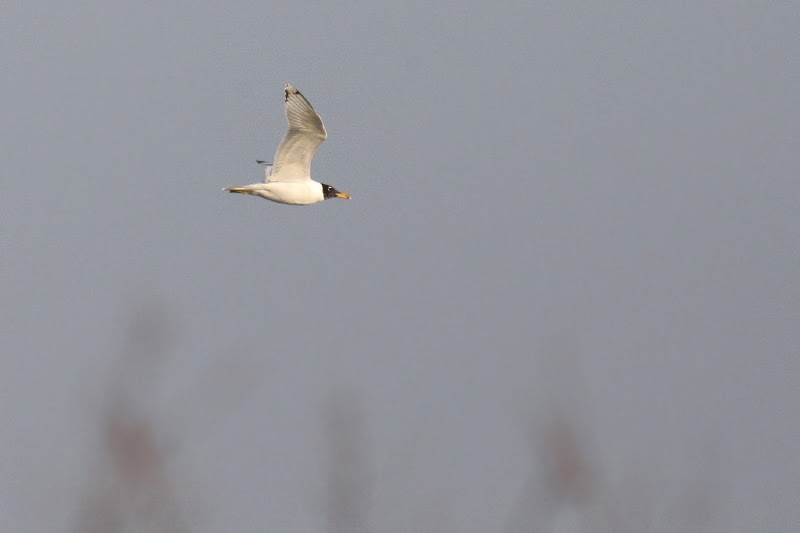Text © K. Gauger & M. Heiß
Arriving at Baku
Airport in the early morning of 16th January we immediately received our cars, which have been
organised by our tour operator Kaspian Tur. For the ten participants of the trip we rented three 4WD cars. After a brief instruction we
had a nice night drive through Baku city just before the rush hour started.
Our first stop was
at the famous Gobustan rock engravings. These are thought to be impressive 5.000
to 40.000 years old. Besides the outstanding cultural value the spot is also
excellent for bird watching. The rocks are year-round highly attractive to a
large variety of species, especially rock-specialists like Rock
Nuthatches that were audible everywhere, Rock Buntings of which we saw 7 in a
flock or 2 pairs of Finsch’s Wheatear.
 |
| Rock formations in Gobustan © Michael Heiß |
 |
| Rock Bunting © Kai Gauger |
 |
| Western Rock Nuthatch © Kai Gauger |
 |
| Crested Lark © Kai Gauger |
Some wintering species were in the rocks as well: Chaffinch,
Sparrow Hawk, Wren, Dunnock, Robin, Song Thrush, Redwing, 2 Goldcrests, 7 Wood
Larks and more than 20 Black Redstarts. Pairs of Red-billed Choughs flew over
and a pair of Spanish Sparrows showed up well at the visitors centre.
Nevertheless, we missed the Wallcreeper that we have seen on our last wintertrip in 2010.
We headed further
south for the next stop in the Shirvan
National Park. Several groups of gazelles were around as usual but two
distant wolves were a nice surprise. Among the passerines
we found mainly Corn Buntings, Meadow Pipits and Common Linnets. Hen Harriers
and Merlins were frequent. A first flock of about 3.000 Little Bustards flew
in some distance. A stop in
the steppe produced flocks of larks, dominated by Skylark and Calandra
Lark, but also 3 or 4 White-winged Larks were among them. This species was a main target for some of us but unfortunately only a few saw them. 9
Lesser White-fronted Geese were among hundreds of Greater White-fronted and Greylag Geese.
 |
| Roadside birding without birds © Lukas Pelikan |
 |
| Roadside birding with Little Bustards © Michael Heiß |
|
|
| Always drive slowly when Little Bustards cross the road © Lukas Pelikan |
 |
| Goitered Gazelles © Michael Heiß |
We stopped at
the ‘Flamingo Lake’ to check the waterfowl and we were
pretty surprised by the species richness. Among the ducks we saw Mallard, Gadwall,
Pintail, Shoveler, Wigeon, Teal, Common and Red-creasted Pochard, Tufted Duck,
Goldeneye and Smew. We counted 25 Bewick’s and 4 Whooper Swans, 5
Common Shelducks, 2 Black-necked Grebes, 19 Dalmatian Pelicans, 12 Flamingos, 3
Pallas’s Gulls, few Purple Swamphens and about 300 Coots. In the reeds we saw
or heard at least 6 Cetti’s Warblers, several Caspian Reed Buntings, Penduline
Tits and Bearded Reedlings. A Black Francolin flushed near the road.
 |
| Bird watching at the 'Flamingo Lake' © Michael Heiß |
 |
| ad Pallas's Gull © Michael Heiß |
 |
| Female Reed Bunting ssp. caspia © Michael Heiß |
 |
Male Reed Bunting ssp. caspia with an impressive bill © Michael Heiß
And another one © Kai Gauger |
 |
| Golden jackal in golden reed © Michael Heiß |
In the evening we counted the roost flight from the ‘Lake House’. There were 744 Pygmy
Cormorants, 205 Marsh Harriers, 40 Hen Harriers, 655 Magpies, 25.000-30.000
Rooks and Jackdaws in mixed flocks and tens of Meadow and coutelli Pipits with a calling
Buff-bellied Pipit among them. An impressive flock of more then 40.000 Little
Bustards was flying around in the distance. Unfortunately, we had to leave the Shirvan National Park. Due to the new regulations we were not allowed to spend the night there. So we
could not camp at our favorite site at the ‘Flamingo Lake’ but did instead
camping in the guestrooms of a friend’s restaurant.
The next morning we visited Shirvan again. The tracks in the
park were dry, so we reached the coast. We checked the Caspian
Sea and found 1 Velvet Scoter, 1 Red-throated and 1 Black-throated Diver,
several Great Crested Grebes and a few waders and gulls including an ad heuglini. In the bushes we
flushed 3 Black Francolins, a Long-eared and a Short-eared Owl and saw also 2
Long-legged and 1 Rough-legged Buzzard, 2 Peregrines,
1 Imperial Eagle and several White-tailed Eagles, Hen Harriers and Merlins. Just before we left
the park we had once again great views on
huge flocks of Little Bustards.
 |
| Flock of Little Bustards along the road © Michael Heiß |
 |
| Some more Little Bustards and one of the oil pumps © Michael Heiß |
















Keine Kommentare:
Kommentar veröffentlichen